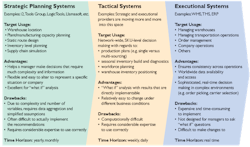Historically, the supply chain software space has been bifurcated into two distinct groups: execution systems and planning systems. Despite the fact that synergies exist between the two, for technological reasons they have not typically been well-integrated or useful to one another. In this article we'll look at aspects of each type of system, (see chart) discuss why there will be more and more integration in the future, and provide a few examples of how supply chain managers can take advantage of the future developments.
Execution Systems
Execution systems have been important for a long time. It seems that nearly every major corporation at this point uses SAP, Oracle, JDA, or some other ERP system as the backbone of its operations. The advantages after implementation are numerous: visibility across the entire company, software and operational consistency across departments, various reporting and business intelligence capabilities, modularity and upgradeability, and a single vendor to interact with. However, these do come at a significant cost: Implementations can take several years to complete and are usually quite expensive.
Additionally, ERP systems are difficult to customize, require workers to learn new systems and skills, and the flip side of having a single vendor to interact with is that the user is locked-in with that same vendor. Warehouse management systems (WMS) and transportation management systems (TMS) are similar to ERP systems in terms of costs and benefits, although the costs are orders of magnitude lower for implementation and complexity.
While these systems are well designed and effective for their intended use, they have major drawbacks when it comes to questions that reside a level above operational issues. For instance, assume I have the capability to make a set of products at two different factories. From a transportation perspective, it is of course cheaper to produce in both factories. However, this will require more changeovers at the factory, lowering my productivity. This indicates that in slow periods I should consider utilizing both factories for each product, whereas in peak periods I should single-source for maximum production efficiency. How does the best policy change with oil prices (and hence transportation costs)? How robust is the plan with regards to differing demand forecasts? Typically, executional systems do not provide much support for this type of “what if” question.
Planning Systems
Planning systems have proven to be useful for answering strategic supply chain questions. Of course, the classic example that has long been in existence is “how many distribution centers should I have and where should they be located?” Software has been used to answer this question since at least the 1970s. Due to its success, many different questions have been asked and answered of a strategic supply chain nature since then. For example, manufacturing capacity planning, plant location analysis, customer-to-DC assignments, setting inventory levels in a multi-echelon network, seasonal pre-build strategy, among many other examples, have been explored by practitioners.
While many of these questions have been successfully addressed, the scope of the solutions has typically resided in the one-off, strategic space. The reason for this is that the size and complexity of the solution to the question is immense.
Take for example a relatively simple network of 1,000 SKUs, 10 production lines, five DCs, 500 ship-tos (perhaps aggregated), and 52 time periods. Multiplying these together to get the size of the problem, the order of magnitude of the number of variables is around 1 billion (of course dependent on the actual problem). And this does not even consider potential plant or DC locations. So obviously, these problems are difficult to solve. This is why, to get answers, the analyst is required to aggregate at some level, such as combining 52 weeks into one year, SKUs into product families, etc.
Due to this requirement to aggregate, these systems have not been widely and effectively used in a tactical or operational environment. For instance, to plan your seasonal inventory plan at a product- and production-line-level, you cannot aggregate products to a product family, and you certainly cannot aggregate time periods above, in my opinion, a weekly level.
Why They Will Integrate
To make planning systems effective on an operational or tactical level, three things need to happen. Computer memory (specifically, RAM) needs to get significantly larger, processing power needs to increase dramatically, and the optimization algorithms need to continue to improve.
For the first, memory and data storage continues to get cheaper and larger at a fast clip. For instance, two years ago a 4 GB RAM computer was relatively standard; now it is easy to find options with 16 GB RAM—a four-fold increase. The change to 64-bit operating systems has helped in this regard, where 4 GB was the upper limit with the 32-bit operating systems.
With regards to processors, they continue to get faster and, more importantly, more parallel. For instance, top-end computers now typically have four cores. This means that the computer can solve four problems at once, as opposed to a single-core processor, which used to be standard. As more and more processors are added, larger problems can be solved (for instance, state-of-the-art supercomputers have thousands and thousands of standard processors operating in parallel).
Finally, the algorithms used to solve these problems need to continue to improve. Here, academia has typically taken the lead. Many researchers, often associated with INFORMS, have studied for years how to structure supply chain problems and how to solve them efficiently and optimally (or, at least, close to optimally). This work will continue so long as our research institutions exist.
Another interesting wrinkle will be the movement of these planning systems to the cloud. This will relieve the need for companies and departments to manage their own large computer systems. The cloud will eventually make nearly limitless space and computing power available to everyone at a relatively low cost. Some optimization companies have already made this move.
For all of these reasons, supply chain planning systems will start to become more tactical and useful in nature for the day-to-day manager. Operational questions will be solved at a level that is implementable. The companies that provide this software are either moving in this direction with their current research and development or will do so in the next few years.
Examples for Managers
Over the last three to four years I have noticed a shift in client requests in the tactical direction. Here are a few representative problems that have been posed:
- A food producer whose products need to be stored at different temperatures for windows of time (i.e., the products have minimum and maximum storage times at each temperature). The producer has limited pallet positions for each temperature-controlled warehouse. Given actual and forecasted demand, how should product be deployed through the set of warehouses and how should the production plan be altered to ensure all warehouses are well-utilized but not over-capacitated?
- A soft drink producer/bottler has multiple production facilities and warehouses. Customer demand is seasonal and during peak seasons exceeds production capacity; hence they pre-build some products and ship to warehouses. Given actual inventory levels, actual and forecasted demand, and a production schedule, what is the most cost efficient option to service each customer? What is the weekly logistics plan for the next few months?
- A manufacturer can make products at multiple plants and ship to all DCs. The options are: multi-source at all plants and have each plant ship to a dedicated DC; multi-source at all plants and distribute to all DCs from all plants; or to single-source product at a plant and serve all DCs from that plant. Due to the different aspects of each possible configuration, the best strategy changes depending on the level of demand and the utilization of the production lines. Hence, this problem needs to be solved at a product and weekly level for the full year, making the problem very large and in the tactical space.
- A consumer goods company operates several DCs nationally whose products are mostly made overseas. The inventory policies are such that products are stocked at some DCs, but not all, to keep inventory levels manageable. Picking orders for customers is labor-intensive and to add shifts requires advance notice and is more costly than a leveled distribution plan. Because inbound shipments and outbound order fulfillment use the same labor supply, how should inbound shipments be scheduled so as to minimize the need to run extra shifts? Should the inventory policies be adjusted on an on-going basis? This problem would need to be addressed at a weekly level, by product, and the result needs to be implementable, hence making it tactical.
As is evident from the examples provided, the difference between tactical and strategic planning typically depends on the time frame involved, the questions that are being addressed, and the level of detail the answer needs to possess. I believe this is the future of supply chain planning systems.
Alex Scott is a Ph.D. student in supply chain management at Penn State University. Prior to this he held several positions at IBM related to supply chain planning and execution. Scott is also a member of MH&L's Editorial Advisory Board.




